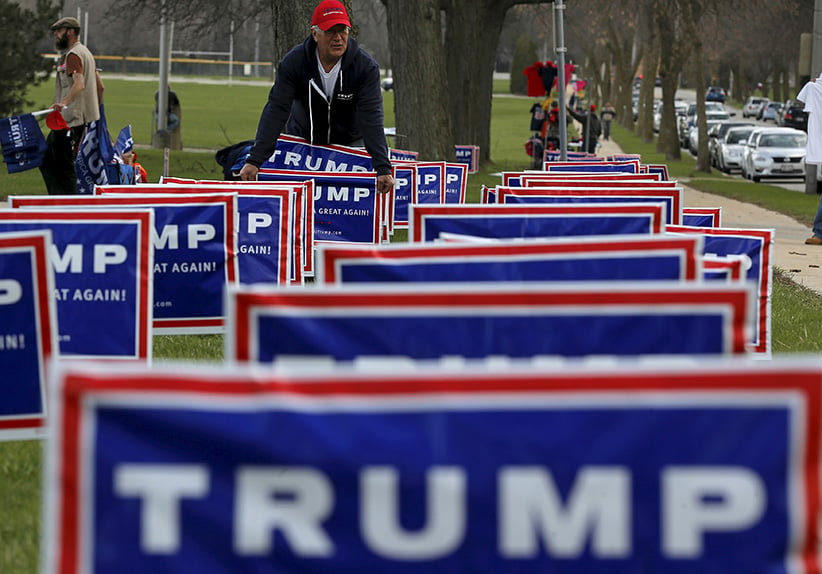In defence of the humble campaign lawn sign
Halifax’s election campaign for mayor is eschewing lawn signs—but they’re evidence of a healthy democracy
Elam Stoltzfus plants lawn signs outside a U.S. Republican presidential candidate Donald Trump campaign rally in West Allis, Wisconsin, United States, April 3, 2016. REUTERS/Jim Young – RTSDEJT
Share

What does Halifax’s mayoral election say about the future of political campaigns? And should we all be worried?
This weekend Haligonians will vote in what might be considered a historic civic election. While there’s nothing unusual about the candidates for mayor—incumbent Mike Savage versus political rookie Lil MacPherson—or the issues in play (experience versus environmental activism), it is believed to be the first contested campaign in Canada conducted without lawn signs.
Savage says he pitched the idea for the two candidates to mutually dispense with lawn signs as a way of making the race more environmentally friendly. Corrugated plastic signs are not recyclable. The vast proliferation of signs during campaigns is considered by many to be a visual blight, and though every sign is supposed to be collected once the voting is over, it’s not uncommon to see wayward signs linger in reservoirs and ditches long after a winner has been declared. “I don’t think that [lawn signs] are necessarily an adornment to the political landscape,” Savage said.
(It was also a brilliant tactical move by Savage, who enjoys broad name-recognition thanks to two terms as a federal MP and one as mayor. He essentially boxed the little-known MacPherson into abandoning one of the most-reliable ways to get her name in front of voters in order to maintain her green credentials.)
Beyond the local politics involved, however, a broader trend may be emerging here. With the ascendance of social media in modern electioneering, we could be witnessing the beginning of the end, not just of lawn signs, but of other kinds of traditional retail politicking. We certainly hope not. Lawn signs are useful and necessary election accessories because they allow people to make a public statement about their voting intentions. Like door-knocking, baby-kissing and attending all-candidates meetings, they’re welcome examples of participatory politics rooted at the street level. This sort of local engagement often leads to face-to-face debates between neighbours and —whether they agree or not—should be considered a healthy thing for democracy at all levels.
Social media has clearly had a profound impact on political campaigns around the world. Twitter, Facebook and other platforms allow politicians to instantly connect with legions of voters (and vice versa) in a way that’s impossible in the corporeal world. Yet growth in interconnectivity comes at a cost. As we’ve written in this space recently, social media has unfortunately become a playground of deplorable behaviour. Stripped of the social conventions that temper physical interactions, online discourse far too frequently consists of foul-mouth, tribal insults. An echo chamber of people yelling past one another. Given the stakes at play, such tendencies are only exaggerated by politics.
So what might a campaign look like in this new world? It would probably look a lot like the current U.S. presidential race between Republican Donald Trump and Democrat Hillary Clinton.
Consider last Sunday’s presidential town hall debate. Rather than engaging in policy discussions or answering thoughtful questions from voters, both candidates seemed more intent on trading cruelties and launching viral memes. After apologizing for saying horrible things about women in general, Trump went on to say horrible things about Clinton in particular. He threatened to put her in jail if he becomes president (a boast that betrays such disdain for the democratic process it alone ought to disqualify him for office). He followed that with the baseless calumny that “she has tremendous hate in her heart.” And while Clinton was certainly more restrained and measured, and began the debate with a promise to “go high” if her opponent “goes low,” she too stooped to name-calling: branding Trump a liar and blaming him for an alleged increase in schoolyard bullying.
The debate, and especially Trump’s performance, appeared to be mostly about hurling insults. They even dispensed with the traditional opening handshake. As the style and method of political communication changes, will such behaviour become the norm?
There have been plenty of poorly behaved politicians and unruly debates long before the invention of social media. The extreme belligerence of Trump is largely to blame for the debasement of the current U.S. campaign. Voters everywhere should be concerned about the underlying trend at work, regardless of the personalities involved. Personal contact and face-to-face interaction remains the only effective means of holding back the vast deluge of invective dispensed online. However old-fashioned or wasteful it may seem, the humble lawn sign remains an important way to keep the political world grounded in physical space, personal accountability and human contact.
Let’s not be too quick to abandon street-level retail politics, and the signs that go with it.